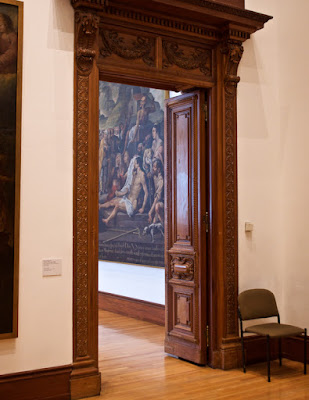Bill and I could not have known what was waiting for us after enjoying the 19th Century landscape paintings on the second floor of Mexico City's National Museum of Art,
We climbed the persuasive staircase
and discovered first, this lovely ballroom.
But the biggest surprise was around the corner when we were thrust into the heart of the Mexican Baroque. I read now that 17th century Spanish painters thrived in New Spain (Mexico). By the 18th century a generation of native Mexican painters were creating religious art of the highest quality.
But the biggest surprise was around the corner when we were thrust into the heart of the Mexican Baroque. I read now that 17th century Spanish painters thrived in New Spain (Mexico). By the 18th century a generation of native Mexican painters were creating religious art of the highest quality.
Miguel Cabrera (ca. 1695-1768) is a justly famous Mexican painter. Here is his Saint Francis Xavier, 1750-1760.
Detail from Saint Francis Xavier. What are these putti doing with this water-filled clamshell?
Detail from Saint Francis Xavier. What are these putti doing with this water-filled clamshell?
As well as the art, I was interested in the gallery guards and their body language. I took this picture without knowing Bill was taking my picture. So I get to see my own body language.
The painting to the right of the door is by Luis Juarez (ca. 1585-1639)
Child Saints Justo and Pastor, ca. 1653
Here's another Luis Juarez: Saint Michael Archangel.
And another Juarez: Guardian Angel. Bill loves the child's demeanour and outfit.
We discovered room after room of Baroque delights.
We discovered room after room of Baroque delights.
I liked this The Virgin of Carmen with Saint Theresa and Saint John of the Cross, 1708,
by Juan Rodriguez Juarez (1675-1728). I like the evocation of a heavenly realm floating so near the mundane.
Here's another Juan Rodriguez Juarez. The Assumption of the Virgin, ca. 1717. Love that heavenly realm!
Here's one last example of Roman Catholic Baroque exuberance. Juan Patricio Morlete Ruiz (1713-1772): The Heart of Maria, ca. 1759. They don't paint pictures like this anymore.
Looks like the gallery has been renovated recently. The flow is quite fresh. These statues are called Liberty (on the left) and America and are by Pedro Patino Ixtolinque, c.1825.
Was fun to see other photographers at work. He would have had to get special permission to use that tripod.
The galleries wrap around a courtyard
so fresh air and natural light are always only a step away.
A very satisfying museum, well worth a visit.






















One should be seen descending that staircase,
ReplyDeletepreferably nude.